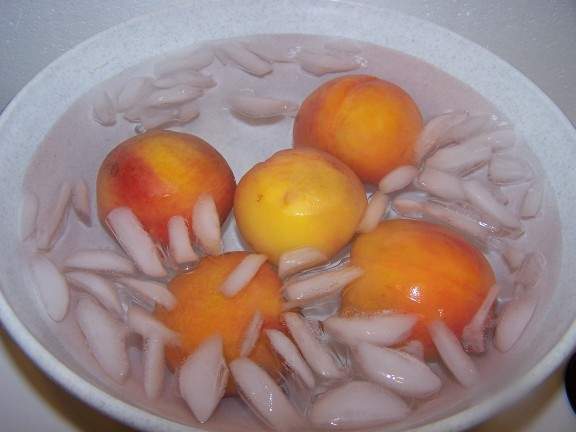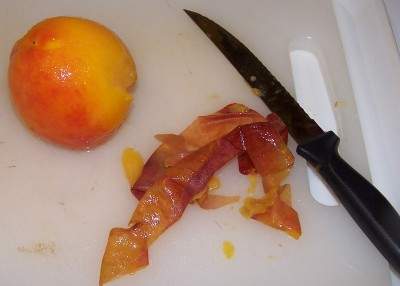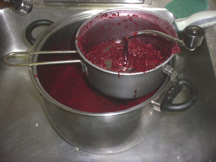
Looking for How to Make Peach Butter - Easy, Illustrated, Reliable Home Canning Recipe, in Simple Steps! in 2025? Scroll down this page and follow the links. And if you bring home some fruit or vegetables and want to can, freeze, make jam, salsa or pickles, see this page for simple, reliable, illustrated canning, freezing or preserving directions. There are plenty of other related resources, click on the resources dropdown above. If you are having a hard time finding canning lids, I've used these, and they're a great price & ship in 2 days.
If you have questions or feedback, please let me know! There are affiliate links on this page. Read our disclosure policy to learn more.
How to Make Peach Butter - Easy, Illustrated, Reliable Home Canning Recipe, in Simple Steps!
How to Make Homemade Peach Butter - Easily!
You think
making and canning your own peach butter is difficult? Well, it used to
be! Until crock pots and slow cookers came along!
Now, it's easy! Here's how to do it, complete instructions in easy steps and completely illustrated. The peach butter will taste MUCH better than anything you've ever had from a store.
Prepared this way, the jars have a shelf life of 18 months to 2 years, and require no special attention. A side benefit is that your house will smell wonderful while it is cooking - much better than potpourri!
Directions for Making peach butter
Ingredients and Equipment
- Peaches - About 35 peaches for a full 6 quart crock pot batch (See step 1)
- Cinnamon
- Cloves
- Allspice
- Jar grabber (to pick up the hot jars)
- Lid lifter (I like the lid rack that holds 12 lids or you can pull them out one at a time with the lid-lifter that has a magnet from the almost-boiling water where you sanitize them. ($4 at Target, other big box stores, and often grocery stores; and available online - see this page)
- Jar funnel ($5 at Target, other big box stores, and often grocery stores; and available online - see this page)
- 1 Crock pot (slow cooker)
- Large spoons and ladles,
- 1 Water Bath Canner (a huge pot to sanitize the jars of peach butter after filling (about $30 to $35 at mall kitchen stores, sometimes at big box stores and grocery stores.))
- Canning jars (often called Ball jars, Mason jars or Kerr jars) (Grocery stores, like Publix, Kroger, Safeway carry them, as do some big box stores - now about $12 per dozen quart jars (up 50% in 2 years!) including the lids and rings)
Peach Butter Recipe and Directions
Step 1 - Selecting the peaches, plums, cherries or nectarinesThe most important step! You need peaches that are sweet, and to make the work easier, cling-free (also called freestone). This means that the peach separates easily from the pit! Same with nectarines, and this doesn't apply to cherries or plums. Choose ripe, mature fruit. They should not be mushy, but they also should not be rock hard: just as ripe as you would eat them fresh. Green, unripe peaches will soften but will not ripen, nor have the flavor of tree-ripe peaches. After this step, I'll just refer to "peaches" but it applies to plums, cherries and nectarines.
|

Step 2 - How many peaches and where to get themYou can pick your own, or buy them at the grocery store. For very large quantities (more than a few bushels), you will find that real* farmer's markets, like the Farmer's Market in Forest Park, Georgia have them at the best prices. It takes about 7 good sized peaches or nectarines (or about 15 plums) to make one quart of prepared peaches. And each quart of prepared peaches cooks down to about 1 pint of peach butter. So that means you will need about 7 large peaches per pint of peach butter that you want to make! For one batch in a 5 to 6 quart crockpot you will need about 35 to 40 medium to large peaches! The rest of the measurements assume you're making one full batch! |
Step 3 -Wash the peaches!I'm sure you can figure out how to wash the peaches in plain cold or lukewarm water.
|
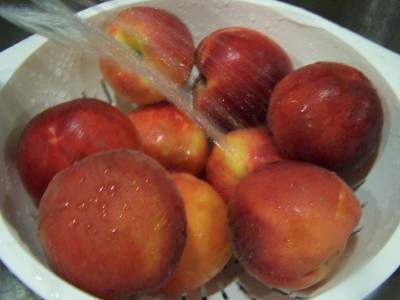 |
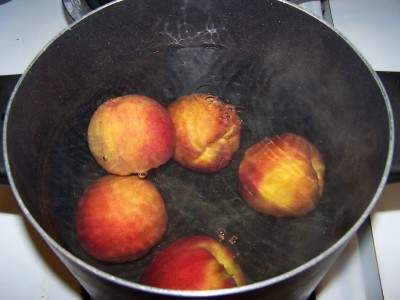 In boiling water for 60 seconds,
then in cold water for 2 min. |
Step 4 - Peeling the PeachesNope, we're not going to peel them by hand; that's way too much work.
Instead, here's a great trick that works with many fruits and vegetables
with skins (like tomatoes): just dip the fruit in boiling water for 30 to
60 seconds. Remove from the water using a slotted spoon and put into
a large bowl or pot of cold water and ice. The skins will easily slide off
now!
Nectarines do not need to be peeled, if you don't mind the skins. |
Step 5 - Cut up and blend the peachesCut out any brown spots and mushy areas. Cut the peaches in half, or quarters or slices, as you prefer! Remove pits! If you want REALLY smooth peach butter, run the cut up peaches through your food processor or blender until they are pureed! |
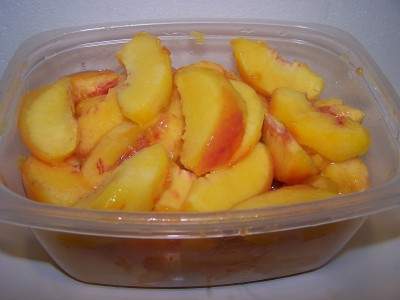 |
Step 6 - Fill the crock pot
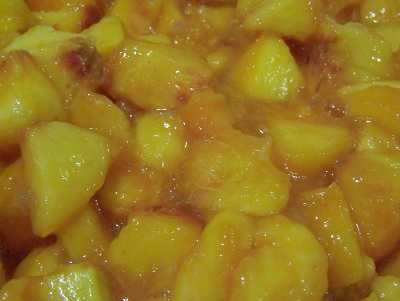 Fill
the crock pot to within an inch of full with the peaches. My crockpot
holds about 5.5 quarts. Now, you CAN do this using a regular large pot on
very low heat on the stove, but the crockpot works much better, because
its heat is very low. I've never had a batch burn in the crockpot.
Fill
the crock pot to within an inch of full with the peaches. My crockpot
holds about 5.5 quarts. Now, you CAN do this using a regular large pot on
very low heat on the stove, but the crockpot works much better, because
its heat is very low. I've never had a batch burn in the crockpot.
Step 7 -Add the spices and sweetener of your choice
To the crockpot full of cut up peaches, add:
- 2 tablespoons of ground cinnamon
- 1 teaspoon ground cloves
- 1/2 teaspoon of allspice
- 4 cups sugar (or other sweetener)
The sweetener can be sugar, Stevia (in a prepared form like Truvia, it measures same as sugar; if you use another form, you will need do your own conversion) - or Splenda, if you prefer, , fruit juice (peach juice or white grape juice work well) or none at all! Generally, a fruit butter, like peach butter is a fairly sweet concoction, so you might want to add some sweetening. I usually add about 2 cups of sugar and 2 cups Splenda (or about 1/3 that if you use Stevia, which is my preference), so it's sweet, but not loaded with sugar.
Step 8 - Cook the Peach butter
Set
the crock pot on low or medium heat.
Some report that even low is too high for overnight and use "warm".
Every crockpot is different; You will need to experiment with your own -
better to go lower than higher.
Cover it loosely or use a large pot splatter-guard. It will spatter as it boils slowly, so I also cover nearby surfaces with towels. You don't want to seal it tightly because you want the steam to escape so it can reduce in volume and thicken.
A visitor suggests, take a couple of butter knives, and lay them across the top of the crock pot. They are parallel and located about 2/3 of the way out from the center. Then put the lid on these supports, leaving it "covering" the pot and keeping the splatters under control, but, leaving a good gap for steam to escape.
Leave it to cook for 6 - 12 hours. How long depends on the size and power of your crockpot, and how thick you like it, If you want to stir it occasionally, that's fine but not necessary. I let mine go overnight.
It will reduce in volume by about half overnight.
Step 9 - Wash the jars and lids
 Now's
a good time to get the jars ready, so you won't be rushed later. The
dishwasher is fine for the jars; especially if it has a "sanitize" cycle,
the water bath processing will sanitize them as well as the contents! If
you don't have a dishwasher with a sanitize cycle, you can wash the
containers in hot, soapy water and rinse, then sanitize the jars by
boiling them 10 minutes, and keep the jars in hot water until they are
used.
Now's
a good time to get the jars ready, so you won't be rushed later. The
dishwasher is fine for the jars; especially if it has a "sanitize" cycle,
the water bath processing will sanitize them as well as the contents! If
you don't have a dishwasher with a sanitize cycle, you can wash the
containers in hot, soapy water and rinse, then sanitize the jars by
boiling them 10 minutes, and keep the jars in hot water until they are
used.
Leave the jars in the dishwasher on "heated dry" until you are ready to use them. Keeping them hot will prevent the jars from breaking when you fill them with the hot peach butter.
Put the lids into a pan of hot, but not quite boiling water (that's what the manufacturer's recommend) for 10 minutes, and use the magnetic "lid lifter wand" to pull them out.
Step 10 - Blend the peach butter (optional)
You
want a smooth, creamy texture, right? If the peach butter is not as
smooth as you'd like, just use a hand-held drink blender. It does a
great job for finishing it up! You can also put
it into a regular blender, but if you are going to do that, you might
want to blend the peach sauce before you put it in the crock pot (it
will be much thicker afterwards and won't move in a regular blender).
Another visitor says running it through a food mill with a fine screen
or through a sieve works, too.
Tips:
- Too thick? if the peach butter cooks down too much or is too thick for your liking, just add a little bit of peach juice and blend it in.
- Not thick enough? Just let it cook some more, with the lid off so the steam can escape!
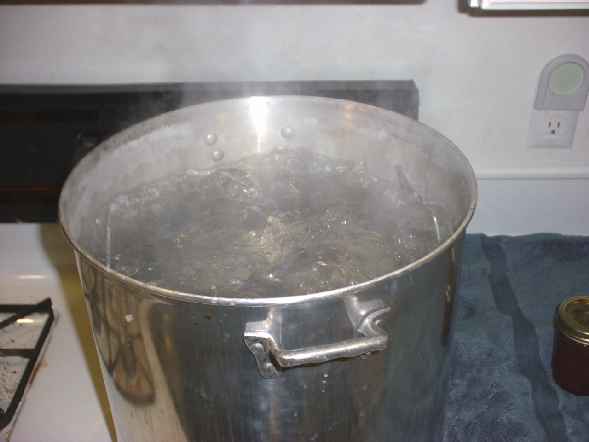 Step
11 - Fill the jars
Step
11 - Fill the jars
Fill them to within 1/4-inch of the top, wipe any spilled peach butter of the top, seat the lid and tighten the ring around them. Put them in the canner and keep them cover with at least 1 inch of water and boiling. if you are at sea level (up to 1,000 ft) boil pint jars for 15 minutes and quart jars for 20 min. If you are at an altitude of 1,000 feet or more, see the chart at the bottom of this page.
Step 12 - Done
Lift
the jars out of the water and let them cool without touching or bumping
them in a draft-free place (usually takes overnight) You can then
remove the rings if you like, but if you leave them on, at least loosen
them quite a bit, so they don't rust in place due to trapped moisture.
Once the jars are cool, you can check that they are sealed verifying
that the lid has been sucked down. Just press in the center, gently,
with your finger. If it pops up and down (often making a popping sound),
it is not sealed. If you put the jar in the refrigerator right away, you
can still use it. Some people replace the lid and reprocess the jar,
then that's a bit iffy. If you heat the contents back up, re-jar them
(with a new lid) and the full time in the canner, it's usually ok.
|
Recommended process time for Peach Butter in a boiling-water canner. |
||||
| Process Time at Altitudes of | ||||
| Style of Pack | Jar Size | 0 - 1,000 ft | 1,001 - 6,000 ft | Above 6,000 ft |
| Hot | Half-pints or Pints | 15 min | 20 | 25 |
| Quarts | 20 | 25 | 30 | |
Frequently Asked Questions
- Q: I have about 18-20 large peaches to work with. I saw
your peach butter recipe in the crock pot. It sounds great. My crock
pot is smaller, just over 3 quarts. Since I have fewer peaches to
work with and a smaller pot, my question is, how much to reduce the
sugar and spices?
A: Certainly! Unlike jam recipes with pectin that are finicky to "set" butter and sauce recipes can be scaled up or down!
Can't find the equipment? We ship to all 50 states!
Canning Books, Supplies and Accessories
These are my favorite essential canning tools, books and supplies. I've been using many of these for over 50 years of canning! The ones below on this page are just the sampling of. my preferred tools. but you can find much more detailed and extensive selections on the pages that are linked below.
- Strainers, pit removers, seed-skin-stem removers, jelly strainers, etc. All types, makes and prices (from $19 to $350)
- Selecting a KitchenAid mixer and attachments for home canning
- Vacuum Foodsealers for freezing, dried foods, and refrigerated foods - the FoodSaver line
- Cherry pitters reviews, prices and ordering
- Steam Juicers
- Food dehydrators - easy and fast to dry your own fruits, veggies, sun-dried tomatoes, etc.
The All New Ball Book Of Canning And Preserving: Over 350 of the Best Canned, Jammed, Pickled, and Preserved Recipes Paperback
This is THE book on canning! My grandmother used this book when I was a child.; It tells you in simple instructions how to can almost anything; complete with recipes for jam, jellies, pickles, sauces, canning vegetables, meats, etc.
If it can be canned, this book likely tells you how! Click on the link below for more information and / or to buy (no obligation to buy)The New Ball Blue Book of Canning and Preserving
Canning and Preserving for Dummies by Karen Ward
This is another popular canning book. Click here for more information, reviews, prices for Canning and Preserving For Dummies
Of course, you do not need to buy ANY canning book as I have about 500 canning, freezing, dehydrating and more recipes all online for free, just see Easy Home Canning Directions.
Home Canning Kits
See here for related tools, equipment, supplies on Amazon See here for related tools, equipment, supplies on Amazon
I have several canners, and my favorite is the stainless steel one at right. It is easy to clean and seems like it will last forever. Mine is 10 years old and looks like new.
The black ones are the same type of standard canner that my grandmother used to make everything from applesauce to jams and jellies to tomato and spaghetti sauce.
This complete kit includes everything you need and lasts for years: the canner, jar rack, Jar grabber tongs, lid lifting wand, a plastic funnel, labels, bubble freer, It's much cheaper than buying the items separately. It's only missing the bible of canning, the Ball Blue Book.
You will never need anything else except jars & lids (and the jars are reusable)!
The complete list of canners is on these pages:
- Water bath canners - Good for acidic foods, like applesauce, pickles, salsa, jams, jellies, most fruits
- Pressure canners - needed for low and non-acidic foods, like canned vegetables (corn, green beans, etc), and meats
- Canners for glass top stoves if you have a glass or ceramic stove
- Canners for induction stovetops
Pressure Canners
If you plan on canning non-acidic foods and low acid foods that are not pickled - this means: meats, seafood, soups, green beans corn, most vegetables, etc., then you ABSOLUTELY must use a Pressure Canner.
Of course, you can use a pressure canner as a water bath canner as well - just don't seal it up, so it does not pressurize. This means a Pressure Canner is a 2-in-1 device. With it, you can can almost ANYTHING.
There are also other supplies, accessories, tools and more canners, of different styles, makes and prices, click here!
Basic Canning Accessories
From left to right:
- Jar lifting tongs to pick up hot jars
- Lid lifter - to remove lids from the pot of boiling water (sterilizing )
- Lids- disposable - you may only use them once
- Ring - holds the lids on the jar until after the jars cool - then you remove them, save them and reuse them
- Canning Jar funnel - to fill the jars
Strainers
These are very useful for making sauces like applesauce, tomato sauce, spaghetti sauce, jellies, etc. Below are my favorites. The complete list is on these pages:
- Strainers, pit removers, seed-skin-stem removers, jelly strainers, etc. All types, makes and prices (from $19 to $350)
- Selecting a KitchenAid mixer and attachments for home canning
Inexpensive Old School Strainers: hand cranked Foley Food Mills
- The hand-cranked Foley food mill (see this page or clock the ad box) has been used for well over 100 years in homes all over America (and variants around the world). It is effective and inexpensive, and ideal for small batches. However, if you need to make many quarts, you will sure end up with tunnel carpel syndrome or some other repetitive strain injury.
Norpro 1951 Manual Food Strainer and other brand stariners, with optional motors; (almost identical to Victorio V250, Villaware and Roma models, all discontinued)
This is The next step up from the Foley food mill. First, it's far more ergonomic, and its handle is easier to use. Next, it works in continuous mode rather than batch mode. So you can do much larger volumes easily. Finally, It has an optional motor, so you can. remove the manual labor. It also offers many different size strainers to use for different types of berries, vegetables and fruit.
See the seller's website for more information, features, pricing and user reviews!
- A Johnny, Weston or Oxo strainer (about $60 - $100, see further down the page) or
- This trainer is. simply a more upscale and improved version of the one above.
- See this page for more information, reviews, descriptions of other strainers and supplies or to order!
KitchenAid - Best Large Volume Strainers
If you're going to do large volumes of fruit or vegetables , or do it year after year, then. you really should think about getting a higher end kitchen. utility device. Kitchen aids are the cream of the crop. Once you buy one of these, you keep at the rest of your life and it gets handed down to the next generation. . My sister is using one she inherited from my mother 25 years ago, who got it in the 1940s as a wedding gift. So, although the initial cost is high, they literally last for many lifetime. So the cost on an annual basis is pretty trivial, especially when you consider the cost of therapy and treatment for. the repetitive strain injuries you will get from manual cranking day after day. Add to that of course the cost of therapy for the emotional injuries you'll get from going insane, standing there hand cranking something for hours.
KitchenAid's with a sieve/grinder (with the attachments, costs about $400, but it lasts a lifetime and is fast and easy to use - I can make 100 quart jars of applesauce per day with one of these).
FREE Illustrated Canning, Freezing, Jam Instructions and Recipes
Don't spend money on books. that you don't need to. Almost everything you can find in some book sold online or in a store is on my website here for free. Start with theEasy Home Canning Directions below. That is a master list of canning directions which are all based upon the Ball Bblue book, the National Center for Home Food Preservation and other reputable lab tested recipes. Almost every recipe I present in addition to being lab tested com. is in a step by step format with photos for each step and complete. explanations. that tell you how to do it, where to get the supplies and pretty much everything you need to know. In addition, there almost always in a PDF format so you can print them out and use them while you cook.
[ Easy Home Canning Directions]
[FAQs - Answers to common questions and problems]
[Recommended books about home canning, jam making, drying and preserving!]
Looking for canning equipment and supplies?
Water bath canner with a jar rack
Pressure canners for gas, electric and induction stoves: Presto 23Qt or T-fal 22Qt
Canning scoop (this one is PERFECT)
Ball Blue book (most recent version)
Jars: 8oz canning jars for jams
Find Other types of farms:
Farm markets and roadside stands
Road trips and camping resources
Local Honey, apiaries, beekeepers
Consumer fraud and scams information
Home canning supplies at the best prices on the internet!
Maple Syrup Farms, sugarworks, maple syrup festivals
Environmental information and resources
Farms For Your Event for birthday parties, weddings, receptions, business meetings, retreats, etc.
Festivals - local fruit and vegetable festivals
Get the
most recent version of
the Ball Blue Book
With this Presto 23 quart pressure canner and pressure cooker, you can "can" everything, fruits, vegetables, jams, jellies, salsa, applesauce, pickles, even meats, soups, stews. Model 01781

You can make jams, jellies, can fruit, applesauce, salsa and pickles with water bath canners, like this Granite Ware 12-Piece Canner Kit, Jar Rack, Blancher, Colander and 5 piece Canning Tool Set

